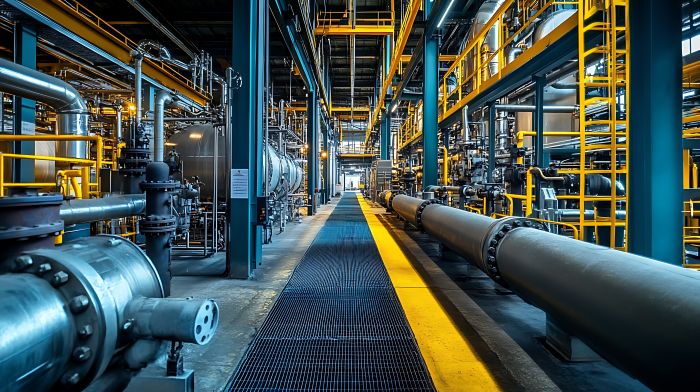Unplanned stops take 3-9 times longer than planned maintenance windows, yet, many manufacturers still treat downtime as an inevitable cost of doing business rather than a strategic opportunity. It may seem straightforward to schedule maintenance during quiet periods, but the reality involves complex decisions about when to intervene, how long repairs will take, and whether that vibration you noticed yesterday will become tomorrow’s catastrophic failure.
The distinction between planned and unplanned downtime isn’t just academic, it’s the difference between controlling your production schedule and having it control you. When maintenance is treated as a strategic function, it can have a significant effect on reliability, profitability, and operational efficiency.
The Hidden Mathematics of Manufacturing Downtime
Every manufacturing facility faces the same fundamental equation: planned maintenance costs roughly $1 for every $3-5 you’ll spend on emergency repairs. Yet despite this simple math, research by Siemens shows that unplanned downtime still consumes up to 11% of Fortune Global 500 companies’ revenue. Translating to $1.4 trillion in annual losses across manufacturing sectors.
The challenge lies not in eliminating downtime entirely, which is impossible, but in transforming unpredictable, costly interruptions into strategic maintenance opportunities. This transformation requires a fundamental shift from “fix it when it breaks” to “fix it before it breaks”, supported by real-time monitoring and predictive insights.
Modern manufacturers who master this balance report uptime improvements of up to 15-25% through strategic downtime management. The difference maker? Understanding that not all downtime is created equal, and more importantly, knowing how to convert unplanned stops into planned maintenance windows.

Planned Downtime: Your Strategic Maintenance Advantage
Manual bolt torque inspections are commonly performed during planned downtime windows, but what if those critical fasteners could communicate their condition continuously? This shift from scheduled checks to real-time monitoring represents the evolution from traditional planned maintenance to intelligent maintenance strategies.
Planned downtime represents intentional production pauses scheduled to maintain, upgrade, or optimize equipment performance. Rather than viewing these intervals as lost production time, forward-thinking manufacturers leverage planned downtime as opportunities to enhance long-term operational reliability.
The Economics of Planning Ahead
Consider two scenarios: a bearing replacement scheduled during next month’s maintenance window versus the same bearing failing during peak production.
The planned replacement costs $500 in parts plus four hours of regular-time labor. The emergency replacement costs the same $500 in parts, but now you’re paying overtime rates, expedited shipping, and losing $15,000 per hour in production value.
Planned maintenance delivers predictable operations where production teams can coordinate with suppliers, adjust delivery commitments, and optimize workforce allocation. This predictability extends throughout the supply chain, enabling better resource management and customer communication. When customers know about scheduled maintenance months in advance, they can adjust their inventory and production plans accordingly.
Safety represents another critical advantage. Controlled maintenance environments significantly reduce workplace risks with accident rates dropping by up to 40% when maintenance occurs during planned downtime rather than emergency conditions. Technicians can follow proper safety protocols without time pressure, use appropriate lifting equipment, and ensure proper lockout/tagout procedures.
Planned Downtime in Practice
Preventive Maintenance Windows involve regular inspection and replacement of wear parts based on manufacturer recommendations or historical performance data. These might include bearing replacements, belt changes, or lubrication services performed during scheduled production breaks. The key is moving from calendar-based schedules to condition-based timing.
Equipment Upgrades and Modifications during planned downtime maximize return on investment while minimizing production disruption. Installing new components, software updates, or process improvements when the line is already down eliminates the double penalty of disruption for both maintenance and upgrades.
Seasonal Maintenance Programs align comprehensive maintenance with naturally slower production periods. Holiday shutdowns, seasonal demand fluctuations, or customer facility closures provide natural windows for major maintenance activities that would otherwise require significant production interruption.
Changeover Optimization transforms necessary production changeovers into maintenance opportunities. Product changeovers include equipment cleaning, configuration changes, and quality verification procedures – perfect times to address minor maintenance items that might otherwise require separate downtime.
Unplanned Downtime: The Profit Killer You Can Predict
Unplanned downtime in manufacturing occurs when equipment fails unexpectedly, forcing immediate production stops. Learn more about how machine downtime affects productivity and profitability here.
These events typically arrive without warning and often during the most inconvenient times, during peak production runs, critical delivery deadlines, or outside normal maintenance hours.
Research indicates that the average manufacturing facility loses 5-20% of annual productivity to unplanned downtime, with costs averaging $260,000 per hour across industries. However, these figures only capture direct production losses. The complete cost tells a different story.
The True Cost of Unplanned Downtime
Unplanned downtime rarely affects just one piece of equipment. Production bottlenecks ripple through interconnected systems, multiplying the impact across entire production lines. A failed pump in one process unit can idle downstream equipment worth millions of dollars in replacement value.
Emergency response costs escalate quickly. Rush orders for replacement parts, overtime labor, expedited shipping, and emergency contractor services can increase repair costs by 300-500% compared to planned maintenance. When a critical bearing fails on a Friday afternoon, that $200 bearing becomes a $10,000 emergency repair by Monday morning.
Quality impacts extend the damage beyond immediate repair costs. Equipment failures often produce off-specification products both before and after the failure event. The costs of rework, scrap, and potential quality issues reaching customers typically cost 5-10 times more than the immediate repair expenses. A temperature controller failure might result in hours of unusable product and days of customer complaints.
Supply chain disruption forces suppliers and customers to adjust their operations, potentially straining relationships and affecting future business opportunities. Customers may find alternative suppliers during extended downtime periods, and those relationships don’t automatically return when production resumes.

Common Causes of Unplanned Downtime in Manufacturing
Equipment degradation accounts for approximately 80% of unplanned downtime events and represents the greatest opportunity for improvement through predictive maintenance strategies. Normal wear and tear progresses to failure when not properly monitored, but this progression typically provides weeks or months of warning signs for those equipped to detect them.
Process variability creates operating conditions that exceed equipment design parameters, often due to demand fluctuations, raw material variations, or operational adjustments. A pump designed for specific viscosity ranges may fail prematurely when process conditions push beyond design limits.
Human factors contribute significantly to unplanned downtime through operating errors, inadequate training, or communication breakdowns that lead to equipment misuse or maintenance oversights. The technician who skips a lubrication point or the operator who ignores an unusual vibration can trigger failures that proper procedures would prevent.
External factors like power outages, supply shortages, environmental conditions, or cybersecurity incidents force production stops, but these events often reveal vulnerabilities in backup systems and emergency procedures that proper planning can address.
Planned vs. Unplanned Downtime Comparison Table
| Aspect | Planned Downtime | Unplanned Downtime |
|---|---|---|
| Timing | Scheduled during low production periods or maintenance windows. | Occurs unexpectedly, often during peak production or critical deadlines. |
| Cost | ~1× maintenance cost (e.g., planned bearing replacement: ~$500 parts + 4 hrs regular-time labor). | 3–5× higher; emergency repair costs often escalate 300–500% and average downtime impact is ~$260,000/hour across industries.1 |
| Production Impact | Controlled stoppage; predictable recovery and coordinated schedules. | Productivity losses of ~5–20% annually; cascading bottlenecks across interconnected lines.1 |
| Safety | Up to ~40% fewer accidents in controlled maintenance environments. | Higher incident risk due to stress, time pressure, and improvised work. |
| Quality | Stable processes; minimal scrap or rework. | Off-spec product before/after failure; quality costs typically 5–10× immediate repair expenses. |
| Labor & Logistics | Regular-time labor; coordinated parts and vendors; aligned with supply chain. | Overtime, expedited shipping, emergency contractors; strained supplier coordination. |
| Customer & Supply Chain | Customers informed in advance; inventory and schedules adjusted proactively. | Disruptions may cause missed deliveries and lost business while operations recover. |
| Strategic Value | Window for upgrades, optimization, and predictive/condition-based tasks. | No strategic gain; firefighting focus just to restore operations. |
The Strategic Shift: From Reactive to Predictive Maintenance
The most successful manufacturers don’t just minimize unplanned downtime, they convert potential unplanned events into planned maintenance opportunities. This transformation relies on three fundamental capabilities:
- Real-time condition monitoring
- Predictive analytics
- and strategic maintenance planning.
Traditional maintenance approaches wait for problems to manifest as obvious symptoms:
Unusual vibrations, temperature increases, or performance degradation.
By then, failure is often inevitable. Advanced condition monitoring detects early changes in equipment behavior weeks or months before failure occurs.
For critical rotating equipment, continuous monitoring of parameters like bearing condition, alignment, and lubrication quality provides early warning of potential issues. When combined with baseline performance data, these systems can predict remaining useful life with remarkable accuracy. The oldest machine becomes the sensor when equipped with appropriate monitoring technology.

From Data to Decisions
Machine learning algorithms analyze historical maintenance data, operating conditions, and equipment performance to identify patterns that lead to failures. These insights enable maintenance teams to schedule interventions during planned downtime windows, preventing unplanned stops.
The most effective predictive maintenance programs integrate multiple data sources: equipment sensors, maintenance histories, operating logs, and environmental factors. This comprehensive approach provides the insights needed to make informed maintenance decisions rather than relying on intuition or arbitrary schedules.
This shift from reactive fixes to predictive insights is already visible in practice. One example is Strainlabs’ patented LED-sensor technology, which monitors bolt preload in real time and detects loosening patterns that indicate developing problems in critical machinery connections. At Gröna Lund amusement park in Stockholm, Strainlabs’ system has been shown to significantly reduce inspection time while adding an extra layer of safety to existing maintenance routines.
“Before Strainlabs’ solution, I estimated that up to 35–40% of our inspection and checking time spent is now related to bolted joints,”
explains Peter Andersson,
Ride Safety Manager at Parks & Resorts Scandinavia. Read the full case here.
Building Your Predictive Maintenance Foundation
Transitioning from reactive to predictive maintenance requires more than just technology, it demands a fundamental change in maintenance philosophy. Successful implementations typically follow a structured approach that prioritizes critical assets and builds capability step by step.
Asset criticality assessment identifies equipment whose failure would have the greatest impact on production, safety, or quality. These assets receive priority for advanced monitoring and predictive maintenance programs. A main production line pump merits different monitoring intensity than a cooling water circulation pump.
Baseline establishment documents normal operating parameters and performance characteristics for critical equipment. This baseline enables detection of subtle changes that indicate developing problems. Without knowing what “normal” looks like, even the most sophisticated monitoring system cannot identify emerging issues.
Maintenance optimization uses predictive insights to optimize maintenance schedules, consolidating activities during planned downtime windows while extending intervals between interventions. The goal is performing maintenance based on actual equipment condition rather than arbitrary time intervals.
KPIs for Machine Downtime: Measuring What Matters
Effective downtime management requires measurement systems that track both performance and improvement opportunities. However, not all metrics provide equal value for decision-making.
Overall Equipment Effectiveness (OEE) combines availability, performance, and quality metrics to provide a comprehensive view of equipment productivity. World-class manufacturers typically achieve OEE scores above 85%, but the journey toward that target requires understanding which factors limit performance most significantly.
Mean Time Between Failures (MTBF) measures the average operating time between equipment failures. Improving MTBF through predictive maintenance demonstrates the effectiveness of condition monitoring programs, but this metric works best when combined with failure mode analysis that identifies why failures occur.
Mean Time to Repair (MTTR) tracks the average time required to restore equipment to service after a failure. Shorter MTTR indicates effective spare parts management, skilled technician availability, and efficient repair procedures, but reducing MTTR addresses symptoms rather than root causes.
Financial Metrics That Matter
Downtime cost per hour quantifies the financial impact of production interruptions, including lost revenue, emergency repair costs, and quality impacts. This metric helps justify investments in predictive maintenance technologies, but requires accurate calculation of all cost components to provide meaningful guidance.
Maintenance cost as percentage of replacement asset value provides insight into maintenance efficiency and helps identify opportunities for optimization. However, this metric can mislead if it encourages deferring necessary maintenance to reduce short-term costs.
Return on investment for predictive maintenance measures the financial benefits of condition monitoring and predictive maintenance programs compared to reactive approaches. Calculating this ROI requires careful accounting of all costs and benefits, including avoided failures and extended equipment life.

Technology Solutions for Downtime Optimization
Modern manufacturing environments benefit from integrated technology solutions that provide comprehensive visibility into equipment health and maintenance requirements. The most effective systems combine multiple technologies to create a complete picture of operational status.
Internet of Things (IoT) and Smart Sensors
IoT-enabled sensors provide continuous monitoring of critical equipment parameters without disrupting normal operations. These systems can detect subtle changes in vibration patterns, temperature fluctuations, or performance deviations that indicate developing problems. The key advantage lies in real-time insights that integrate seamlessly with existing manufacturing systems.
Integrated Maintenance Management Systems
Computerized Maintenance Management Systems (CMMS) provide the organizational framework for effective downtime management. These platforms integrate work order management, inventory control, and maintenance scheduling with condition monitoring data to optimize maintenance activities. The most effective implementations link CMMS platforms with real-time condition monitoring systems, enabling automatic work order generation when equipment parameters exceed acceptable limits.
Advanced analytics platforms process data from multiple sources to identify patterns and predict equipment behavior. These systems learn from historical maintenance data, operating conditions, and equipment performance to provide increasingly accurate predictions of maintenance requirements. Machine learning algorithms can identify complex relationships between operating parameters that human analysis might miss.
Predictive Analytics Platforms
Advanced analytics platforms process data from multiple sources to identify patterns and predict equipment behavior. These systems learn from historical maintenance data, operating conditions, and equipment performance to provide increasingly accurate predictions of maintenance requirements.
Machine learning algorithms can identify complex relationships between operating parameters that human analysis might miss. This capability enables more precise prediction of equipment failures and more effective scheduling of preventive maintenance activities.
Building a Maintenance Culture That Delivers
Technology alone cannot eliminate unplanned downtime. Successful downtime management requires organizational commitment to proactive maintenance principles, which typically involves changes in training, communication, and performance measurement systems.
Front-line operators represent the first line of defense against equipment failures. Comprehensive training programs that teach operators to recognize early signs of equipment problems can significantly reduce unplanned downtime. Effective training combines theoretical knowledge with hands-on experience, teaching operators to interpret equipment sounds, vibrations, and performance indicators that might indicate developing problems.
Maintenance technicians require specialized skills to effectively implement predictive maintenance programs. Training should encompass both traditional mechanical skills and modern condition monitoring technologies. The most successful maintenance teams combine experienced technicians who understand equipment mechanical principles with newer team members skilled in data analysis and digital technologies.
Performance management systems should align individual and team objectives with downtime reduction goals. Maintenance teams should be measured and rewarded based on equipment reliability metrics rather than just response times to equipment failures. Operations teams should similarly be incentivized to support planned maintenance activities and provide early notification of equipment problems rather than pushing equipment to failure to meet short-term production targets.
Industry-Specific Realities
Different manufacturing sectors face unique challenges in managing planned and unplanned downtime. Understanding these sector-specific factors enables more effective downtime management strategies tailored to operational realities.
Continuous process operations, such as chemical manufacturing or oil refining, face particular challenges with unplanned downtime due to complex interdependencies between process units. Failure of a single critical component can force shutdown of entire production trains. Predictive maintenance in process industries often focuses on rotating equipment like pumps, compressors, and turbines, which represent common failure points.
Assembly operations and discrete manufacturing face different downtime challenges, often related to complex automation systems and material handling equipment. Unplanned downtime in these environments frequently involves electrical or control system failures rather than mechanical issues. Predictive maintenance strategies for discrete manufacturing often emphasize preventive replacement of electrical components and proactive maintenance of automation systems.
Heavy industries like mining and steel production operate equipment under extreme conditions that accelerate wear and increase failure risks. These environments require robust condition monitoring systems capable of detecting problems in harsh operating conditions. Maintenance strategies for heavy industry often emphasize trending analysis and wear monitoring to predict when equipment will reach end-of-life conditions.

The Path Forward: From Reactive to Strategic
The difference between planned and unplanned downtime is more than just an operational detail — it reflects an organization’s overall approach to manufacturing excellence. Companies that can turn unexpected interruptions into planned maintenance opportunities gain a real competitive edge through higher reliability, lower costs, and stronger safety performance.
Successful downtime management isn’t just about technology. It’s about pairing smart monitoring with a culture of proactive maintenance. The real value comes from building systems that reveal issues early, and having teams ready to act on those insights.
As industries move toward digitalized components, from bolted joints to entire production lines, the ability to predict and prevent breakdowns becomes central to staying competitive. Today’s technologies create opportunities to achieve new levels of operational excellence through predictive insights and strategic downtime management.
The real question is not whether your organization can afford to invest in predictive maintenance and condition monitoring systems, but whether it can afford to continue operating with reactive maintenance approaches that leave operational performance vulnerable to unpredictable equipment failures.
When maintenance becomes a strategic function rather than a necessary cost, it transforms into a source of competitive advantage that drives improved operational reliability, enhanced profitability, and sustainable manufacturing excellence.

